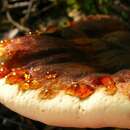en
names in breadcrumbs


Identification of this species is easy with close examination. The fungus grows a shelf like cap similar to many other polypores. The top surface is brown to dark brown with traces of dark orange. The underside is a very clean white bruising easily to dark tan/brown when contacted with mild pressure. Ischnoderma resinosum spores leave an off whitish print. The spores are hyaline and cylindric/sausage like with sizes ranging from 4.5-7 × 1.5-2.5μm. The cap will slowly turn a dark gray/black with application of 3% KOH.
Ischnoderma resinosum is found in moderate hardwood forests throughout North America. It grows primarily on fallen hardwoods. It is generally not found on heavily decayed logs.
Ischnoderma resinosum (Fr.) Karst. is a polypore common in the North American hardwood forests. It is easily identifiable upon a detailed inspection. When fresh, it is a characteristically soft polypore with a notably velvet like texture on the top portion of its cap. The vast majority of specimens are fan shaped on decaying hardwoods with caps that can range from 3-10”. The velvety top surface has notable zones/rings that radiate outward from the point of attachment. Young specimens are distinctly moist and will seep water when crushed. Distinct from other polypores, Ischnoderma resinosum is very fleshy especially when young. The spore bearing underside is white but quickly turns brown and bruises with slight pressure. As the specimen becomes larger and ages, it quickly becomes tough with a leather like texture similar to other polypores.
Common name: Resinous Polypore

Ischnoderma resinosum is restricted to growing on dead hardwoods. Generally this species favors 1-2 year old logs as opposed to freshly fallen trees.
Ischnoderma resinosum is commonly mistaken in Europe with Ischnoderma benzoinus, which is found to grow on conifers. The two are separated by many mycologists with Ischnoderma resinosum’s significantly darker flesh on the top of the fruiting body.
Ischnoderma resinosum currently has no practical industrial use. However it is an important part in the decay of many dead hardwoods, especially ~2 years after their death. It is considered to be inedible by many. However, the younger specimens can be consumed and are enjoyed by some people. For human consumption the younger fungi are chosen simply due to their softer texture.
Ischnoderma resinosum is a species of fungus in the family Fomitopsidaceae. Commonly known as the late fall polypore, resinous polypore, or benzoin bracket, this shelf mushroom is 7–25 cm (3–10 in) across, velvety, dark red/brown, darkening and forming zones in age.[1] Its spongy but tough, sweet-smelling flesh exudes a red liquid when young. This fungus fruits on hardwood logs and stumps in late autumn. A widely distributed species, it has been recorded from Africa, Asia, Europe, and North America.[2]
The species was originally described as Boletus resinosus in 1794 by German botanist Heinrich Schrader. It has acquired an extensive synonymy in its taxonomic history, having been juggled between several genera. Petter Karsten transferred it to Ischnoderma in 1879 to give it the name by which it is currently known.[3] Young, soft specimens may be cooked and eaten, but the species becomes hard and unpalatable later in life.[4]
Ischnoderma benzoinum is similar and has darker flesh.[1]
Ischnoderma resinosum is a species of fungus in the family Fomitopsidaceae. Commonly known as the late fall polypore, resinous polypore, or benzoin bracket, this shelf mushroom is 7–25 cm (3–10 in) across, velvety, dark red/brown, darkening and forming zones in age. Its spongy but tough, sweet-smelling flesh exudes a red liquid when young. This fungus fruits on hardwood logs and stumps in late autumn. A widely distributed species, it has been recorded from Africa, Asia, Europe, and North America.
The species was originally described as Boletus resinosus in 1794 by German botanist Heinrich Schrader. It has acquired an extensive synonymy in its taxonomic history, having been juggled between several genera. Petter Karsten transferred it to Ischnoderma in 1879 to give it the name by which it is currently known. Young, soft specimens may be cooked and eaten, but the species becomes hard and unpalatable later in life.
Ischnoderma benzoinum is similar and has darker flesh.